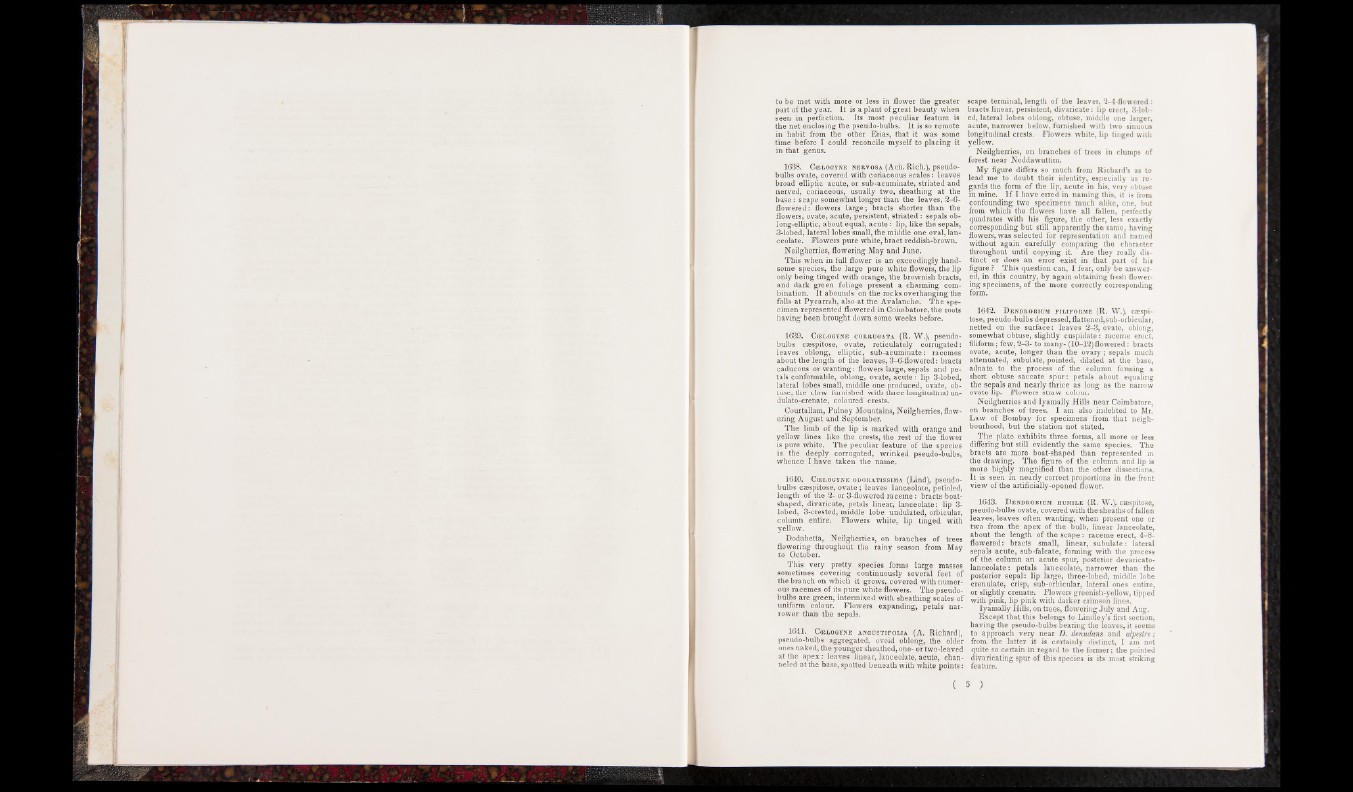
to be met with more or less in flower the greater
part of the year. It is a plant of great beauty when
seen in perfection. Its most peculiar feature is
the net enclosing the pseudo-bulbs. It is so remote
in habit from tne other Erias, that it was some
time before I could reconcile myself to placing it
in that genus.
1638. Ccelogyne nervosa (Ach. Rich.), pseudo-
bulbs ovate, covered with coriaceous scales: leaves
broad elliptic acute, or sub-acuminate, striated and
nerved, coriaceous, usually two, sheathing at the
b a se : scape somewhat longer than the leaves, 2-6-
flowered: flowers larg e; bracts shorter than the
flowers, ovate, acute, persistent, striated: sepals oblong
elliptic, about equal, acute: lip, like the sepals,
3-lobed, lateral lobes small, the middle one oval, lanceolate.
Flowers pure white, bract reddish-brown.
Neilgherries, flowering May and June.
This when in full flower is an exceedingly handsome
species, the large pure white flowers, the lip
only being tinged with orange, the brownish bracts,
and dark green foliage present a charming combination.
It abounds on the rocks overhanging the
falls at Pycarrah, also at the Avalanche. The specimen
represented flowered in Coimbatore, the roots
having been brought down some weeks before.
1639. CffiLOGYNE CORRTJGATA (R. W.), pseudo-
bulbs caespitose, ovate, reticulately corrugated:
leaves oblong, elliptic, sub-acuminate: racemes
about the length of the leaves, 3-6-flowered: bracts
caducous or wanting: flowers large, sepals and petals
conformable, oblong, ovate, acute: lip 3-lobed,
lateral lobes small, middle one produced, ovate, obtuse,
the claw furnished with three longitudinal un-
dulato-crenate, coloured crests.
Courtallam, Pulney Mountains, Neilgherries, flowering
August and September.
The limb of the lip is marked with orange and
yellow lines like the crests, the rest of the flower
is pure white. The peculiar feature of the species
is the deeply corrugated, wrinked pseudo-bulbs,
whence I have taken the name.
1640. CffiLOGYNE odoratissima (Lind), pseudobulbs
caespitose, ovate ; leaves lanceolate, petioled,
length of the 2- or 3-flowered raceme: bracts boatshaped,
divaricate, petals linear, lanceolate: lip 3-
lobed, 3-crested, middle lobe undulated, orbicular,
column entire. Flowers white, lip tinged with
yellow.
Dodabetta, Neilgherries, on branches of trees
flowering throughout the rainy season from May
to October.
This very pretty species forms large masses
sometimes covering continuously several feet of
the branch on which it grows, covered with numerous
racemes of its pure white flowers. The pseudobulbs
are green, intermixed with sheathing scales of
uniform colour. Flowers expanding, petals narrower
than the sepals.
1641. CffiLOGYNE angustifolia (A. Richard),
pseudo-bulbs aggregated, ovoid oblong, the older
ones naked, the younger sheathed, one- or two-leaved
at the ap e x : leaves linear, lanceolate, acute, channeled
at the base, spotted beneath with white points:
scape terminal, length of the leaves, 2-4-flowered:
bracts linear, persistent, divaricate: lip erect, 3-lobed,
lateral lobes oblong, obtuse, middle one larger,
acute, narrower below, furnished with two sinuous
longitudinal crests. Flowers white, lip tinged with
yellow.
Neilgherries, on branches of trees in clumps of
forest near Neddawuttim.
My figure differs so much from Richard’s as to
lead me to doubt their identity, especially as regards
the form of the lip, acute in his, very obtuse
in mine. If I have erred in naming this, it is from
confounding two specimens much alike, one, but
from which the flowers have all fallen, perfectly
quadrates with his figure, the other, less exactly
corresponding but still apparently the same, having
flowers, was selected for representation and named
without again carefully comparing the character
throughout until copying it. Are they really distinct
or does an error exist in that part of his
figure ? This question can, I fear, only be answered,
in this country, by again obtaining fresh flowering
specimens, of the more correctly corresponding
form.
1642. Dendrobiuh fxliforme (R. W.), casspi-
tose, pseudo-bulbs depressed, flattened, sub-orbicular,
netted on the surface: leaves 2-3, ovate, oblong,
somewhat obtuse, slightly cuspidate: raceme erect,
filiform; few, 2-3- to many- (10—12) flowered: bracts
ovate, acute, longer than the ovary; sepals much
attenuated, subulate, pointed, dilated at the base,
adnate to the process of the column forming a
short obtuse saccate spur: petals about equaling
the sepals and nearly thrice as long as the narrow
ovate lip. Flowers straw colour.
Neilgherries and Iyamally Hills near Coimbatore,
on branches of trees. I am also indebted to Mr.
Law of Bombay for specimens from that neighbourhood,
but tne station not stated.
The plate exhibits three forms, all more or less
differing but still evidently the same species. The
bracts are more boat-shaped than represented in
the drawing. The figure of the column and lip is
more highly magnified than the other dissections.
It is seen in nearly correct proportions in the front
view of the artificially-opened flower.
1643. Dendrobium homile (R. W.), caespitose,
pseudo-bulbs ovate, covered with the sheaths of fallen
leaves, leaves often wanting, when present one or
two from the apex of the bulb, linear lanceolate,
about the length of the scape: raceme erect, 4-8-
flowered: bracts small, linear, subulate: lateral
sepals acute, sub-falcate, forming with the process
of the column an acute spur, posterior devaricato-
lanceolate: petals lanceolate, narrower than the
posterior sepal: lip large, three-lobed, middle lobe
crenulate, crisp, sub-orbicular, lateral ones entire,
or slightly crenate. Flowers greenish-yellow, tipped
with pink, lip pink with darker crimson lines..
Iyamally Hills, on trees, flowering July and Aug.
Except that this belongs to Lindley’s first section,
having the pseudo-bulbs bearing the leaves, it seems
to approach very near D. denudans and alpestre;
from the latter it is certainly distinct, I am not
quite so certain in regard to the former; the pointed
divaricating spur of this species is its most striking
feature.
( S )